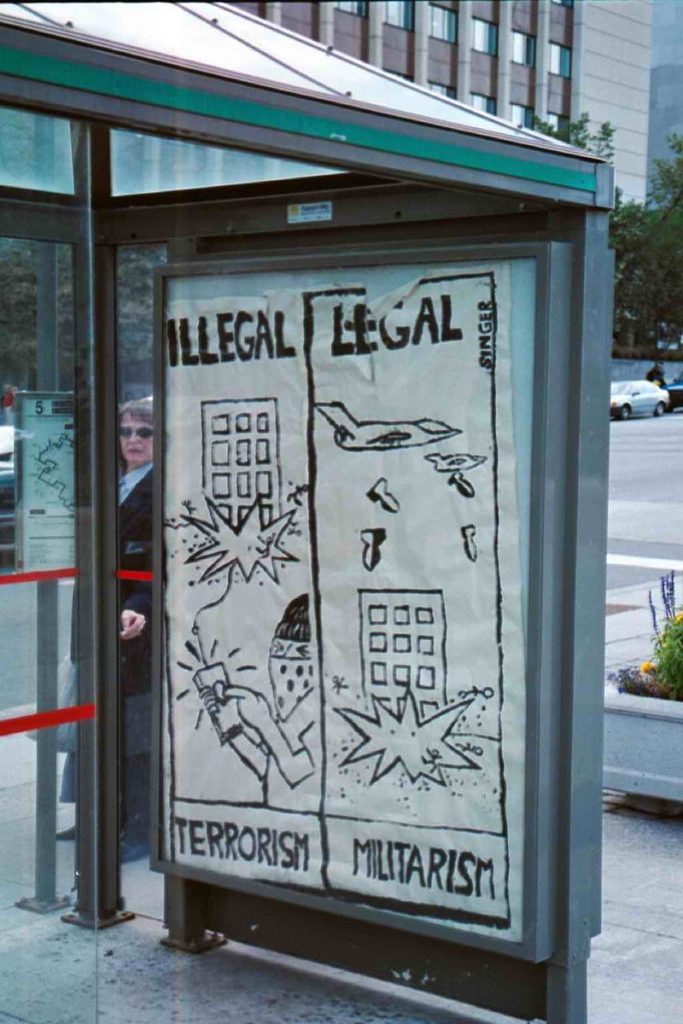Pax et Bellum | Global, Marcus Anderbrant, Opinions, Terrorism, Violence against Civilians |
In the wake of 9/11 terrorism came to put its stamp on policy as well as public discourse. Not only has it figured in matters related to national security but also in debates concerning migration and religion. Yet, terrorism is in no way a new phenomenon. As a matter of fact, terrorism has occurred throughout history. Nowadays, the concept is intimately related to non-state actors but a historical review of the phenomenon shows that states are equally capable of engaging in terrorist acts. Despite the existence of clear-cut definitions, a certain degree of vagueness surrounds the term: is terrorism an ideology? Is it a tactic? Is terrorism defined when winners write history?This post argues that the way we perceive terrorism has implications not only for our understanding of the phenomenon as such, but also for conflict resolution and how it can be effectively opposed. In an increasingly polarized world where the global fight against terror sometimes appears to be one of few global issues offering a platform for collaboration, it seems only reasonable to determine exactly what terrorism is in comparison to our own attitude towards it.
Even though terrorism was not a new phenomenon, it gained a unique position in Western public discourse in the post-9/11 society. It is often portrayed as being the biggest security threat of our time, which as a consequence has created a dichotomy between a terrorism-infested society versus one free from this category of violence. Hence, it has come to affect policies associated with national security in a wide range of countries. Not only in terms of the comprehensive military agenda stemming out of former US president Bush’s War on Terror-doctrine, to some it has also become an important aspect regarding issues such as migration and border control. Despite their prominent position in Western public debate, terrorist attacks are relatively rare and geographically delimited events (Kluch and Vaux, 2016, pp. 1045-1046), and although they have become more frequent in OECD member countries, they are far deadlier among non-OECD members where a few countries account for the vast majority of cases (Institute for Economics & Peace, 2016, pp. 4-13). In times of increased polarization and populist tendencies terrorism also exhibits certain unifying traits:
“Many world leaders claim that the way out of deepening divisions is to unite around the shared goal of fighting terrorism. But that is an illusion: Terrorism is just a tactic, and fighting a tactic cannot define a strategy” (Guéhenno, 2017).
Those were the words of Jean-Marie Guéhenno, president and CEO of International Crisis Group, in his Foreign Policy article 10 Conflicts to Watch in 2017. This highlights one of the great hazards when dealing with terrorism: although people generally have a relatively distinct idea about the concept – its meaning is somewhat vague. Acts of terror are associated with actors who then become terrorist groups, partly implying that some state of terror would be a goal itself – illustrated by a speech given by former president Bush (as cited in BBC News April 4, 2002) stating that: “No nation can negotiate with terrorists, for there is no way to make peace with those whose only goal is death”. Yet, simply treating terrorism as an ideology of murder with an insatiable desire for death tolls would be an over-simplification. After all, although it is a cliché, the old saying “one person’s terrorist is another’s freedom fighter” makes intuitive sense.
Although definitions of terrorism encompass a wide array of subjective interpretations, there are some coherent patterns in the most common ones. For example, the US Department of Defense (2017, p. 236) and the United Nations (1999) alike emphasize terrorism’s objective to pursue political goals via intimidation and fear, where the latter also specifically points out civilians as its targets. Hence, these perceptions of terrorism view terrorists as political agents whose aim is to inflict fear on an audience.

Primoratz (1990, p. 131) elaborates this train of thought further by emphasizing how terrorism has two targets: the indirect primary target and the direct secondary target. The latter refers to victims of a terror attack unfortunate enough to be in the wrong place at the wrong time, who function as a means to inflict fear among the bigger population – the indirect primary target (Ibid). It must be acknowledged that the tactic has repeatedly proven a successful tool in terms of causing fear. Subsequently, fear becomes the means of political change; the implication of which is the understanding of terrorism as acts used in a purely instrumental fashion.
Yet, how come certain actors favour terrorism as their strategic choice when others do not? Crenshaw (1981, pp. 387-388) has suggested that it is the result of resource and power asymmetries. Actors committed to fighting have no desire to give up their cause simply because they lack the ability to fight conventionally, resulting in attempts “to focus whatever may be one side’s comparative advantages against its enemy’s relative weaknesses” (Dunlap, 1998, p. 1), which is the ambition of all warfare, conventional as well as unconventional (Ibid).
Although difficult to define, conventional warfare is usually understood as taking place in the setting of an interstate conflict (where state troops fight another state’s troops) or civil wars (where a state fights non-state insurgents). In the latter, guerrillas have been commonly associated with an interest of territorial control, which separates them from terrorists’ ambitions to spread fear (although, these categories sometimes overlap). Furthermore, guerrillas are usually known to target the opponent’s combatants while terrorists are typically characterized as targeting civilians (Martin and Weinberg, 2016, pp. 238-242).
Herein lies perhaps the main concern regarding how terrorism is viewed. The main difference between terrorism and state-based violence as well as guerrilla warfare is its proneness to target civilians, where other actors mainly focus on rival combatants. Is the fact that terrorism targets civilians the reason why it has emerged as one of the main security threats? Would actors employing terrorist strategies be considered less dangerous if instead they targeted other combatants? As illustrated by the previous quote by former president Bush, one way to conceive the actors is to define them as synonymous to their deeds. Yet, when briefly reviewing the history of terrorism, a more complex image emerges.
As early as in the 1st century, the Jewish group Sicarii engaged in assassinations in response to the Roman occupation (Chaliand and Blin, 2016, pp. 2-3). However, the concept of terrorism has not always been associated with non-state actors. In fact, during the French Revolution it was initially associated with state-based atrocities before, ironically, it became the hallmark of the infamous revolutionary Maximilien de Robespierre who let multiple counter-revolutionaries end their days at the guillotine (Erlenbusch, 2015, pp. 193-195).
Although recently taken into question (Parker and Sitter 2016), the understanding of terrorism has lately found its point of departure in Rapoport’s (2002, p. 2) Four Waves of Terrorism; the Anarchist Wave (which appeared in the 1880’s), the Anti-Colonial Wave (in the 1920’s), the New Left Wave (in the 1960’s) and the Religious Wave (beginning in the late 1970’s). A shared attribute for all the waves is their revolutionary aspect – generally, those actors commonly referred to as terrorist groups usually entail an ideological package drawing upon perceived societal injustices which they seek to combat (Ibid). As Rapoport argues, even though terrorist groups can be combated and defeated by military means “another inspiring cause for hope is likely to emerge” (Ibid, p. 15). As he is able to show, even though terrorism exhibits a wide range of strategies and tactics throughout the cause of time – terrorist actors are complex and find themselves fighting for change (Ibid, p. 2).
The interaction between state and non-state actors in relation to who is applying terrorism reconnects with Primoratz who argues that “even the most enlightened, liberal, democratic states have occasionally engaged in terrorism: witness the bombing of Dresden and Hamburg, Hiroshima and Nagasaki. In all these cases the targets were neither military nor industrial, but rather major centres of civilian population of enemy countries; the objective was to destroy the morale and break the will of the population” (1990, p. 134).

Hence, state and non-state actors alike have historically exhibited the same ability to engage in terrorist strategies, with a striking belief in the political gains to be derived from a state of general fear. Furthermore, terrorism is not a permanent category for actors who find themselves labelled as such; as manifested by Nelson Mandela and his ANC, accused of being terrorists by some, only to have the former sharing the Nobel Peace Prize along with Frederik Willem de Klerk in 1993. Paradoxically, even the Global War on Terror consists of components similar to terrorism. Due to the clandestine nature of its targets, incarcerating or eliminating all the world’s terrorists is likely to be an impossible endeavour. Yet, targeting some sends a message which will possibly deter actors from engaging in terrorism in the future.
When examining the theoretical conceptions of terrorism, this post concludes that 1) terrorism is a tactic functioning as a means to create a platform for political change by imposing fear on a broader population, 2) what separates terrorism from other military strategies is first and foremost its proneness to deliberately attack civilians and 3) throughout history state and non-state actors alike have engaged in terrorist strategies. As suggested before, terrorism is in many cases a way of adapting tactics to battleground conditions. This has an implication for our understanding of terrorists; although often ideologically driven – terrorism is not a direct consequence of the ideologies themselves. In fact, many actors associated with terrorism would define themselves as engaging in resistance or revolutionary fighting. That changes the nature of the relationship between war and terrorism.
Martin and Weinberg (2016, p. 248) argue that terrorism and war should not be subjected to isolated scrutiny, especially emphasizing that terrorism is a tactic employed in warfare and not a separate phenomenon. This understanding of the concept can be a source of optimism: wars and armed conflicts end. Proactively fighting terrorism thus calls for a transformation of political agents’ behaviours as they pursue political goals, which implies the need for functional political processes that do not marginalize certain groups. One contemporary example of the opposite is the Sunni demonstrations in Iraq preceding the emergence of the Islamic State (Gopal, 2016).
In conclusion, this post is far from capable of capturing the complexity surrounding terrorism. It does however suggest that terrorism, first and foremost, should be treated as a tactic because this offers clear benefits as to how it can be counteracted. Instead of viewing a terrorist’s act as an end in itself, this post suggests that a terrorist is a strategic actor who balances political visions against capacities. This, in turn, entails that such an actor is equally capable of adopting different strategies than terrorism – and violence in general.
It is obvious that precautionary measures should be taken to protect civilians from terror and violence. Yet, returning to Guéhenno’s quote, when world leaders’ gather around the common ambition to fight terrorism, what should define the strategy is not primarily the terror itself, but rather how to construct politically sound environments where violence does not emerge as a conceivable tool to achieve political change.
Marcus Anderbrant
The blog is run independently of the Department of Peace and Conflict Research in Uppsala. The Pax et Bellum Editorial Board oversees and approves the publication of all posts, but the content reflects the authors’ own perspectives and opinions.
REFERENCES
- BBC News (2002) “Extracts from Bush’s speech.”, BBC News, April 4, 2002, accessed February 26, 2017. http://news.bbc.co.uk/2/hi/middle_east/1911665.stm
- Chaliand, Gérard and Blin, Arnaud (red.) (2007) “The history of terrorism: from antiquity to ISIS, Updated edition.,” (University of California Press, 2007)
- Crenshaw, Martha (1981) “The causes of terrorism.” Comparative Politics 13 (4): 379-99.
- Department of Defense (2017) “DOD Dictionary of Military and Associated Terms.”, February 2017, accessed February 26, 2017. http://www.dtic.mil/doctrine/new_pubs/dictionary.pdf
- Dunlap Jr, Charles. J. (1998) “Preliminary observations: Asymmetrical warfare and the Western mindset.” Accessed February 27, 2017. Available at http://scholarship.law.duke.edu/cgi/viewcontent.cgi?article=5697&context=faculty_scholarship
- Erlenbusch, Verena (2015) “Terrorism and revolutionary violence: The emergence of terrorism in the french revolution.” Critical Studies on Terrorism 8 (2): 193-210.
- Gopal, Anand (2016) “The Hell After ISIS.” The Atlantic, May, 2016, accessed February 27, 2017. https://www.theatlantic.com/magazine/archive/2016/05/the-hell-after-isis/476391/
- Guéhenno Jean-Marie (2017) “10 Conflicts to Watch in 2017.” Foreign Policy, January 5, 2017, accessed February 26, 2017. https://foreignpolicy.com/2017/01/05/10-conflicts-to-watch-in-2017/
- Institute for Economics & Peace (2016) “Global Terrorism Index 2016: Measuring And Understanding The Impact Of Terrorism.” Accessed February 26, 2017. http://economicsandpeace.org/wp-content/uploads/2016/11/Global-Terrorism-Index-2016.2.pdf
- Kluch, Sofia Pinero, and Alan Vaux (2016) “The non-random nature of terrorism: An exploration of where and how global trends of terrorism have developed over 40 years.” Studies in Conflict & Terrorism 39 (12): 1031-49.
- Martin, Susanne, and Leonard B. Weinberg (2016) “Terrorism in an era of unconventional warfare.” Terrorism and Political Violence 28 (2): 236-53.
- Parker, Tom, and Nick Sitter (2016) “The four horsemen of terrorism: It’s not waves, it’s strains.” Terrorism and Political Violence 28 (2): 197-216.
- Primoratz, Igor (1990) “What is terrorism?” Journal of Applied Philosophy 7 (2): 129-38.
- Rapoport, David C. (2002) “The four waves of rebel terror and September 11.” Anthropoetics, 8(1), 1-17, accessed February 26, 2017. http://www.anthropoetics.ucla.edu/archive/ap0801.pdf
- United Nations (1999) “International Convention for the Suppression of the Financing of Terrorism.” December 9, 1999, accessed February 26, 2017, http://www.un.org/law/cod/finterr.htm

